Vehicle Systems & Engine Technology: Unit 25 Assignment Report
VerifiedAdded on 2023/01/19
|7
|1322
|70
Report
AI Summary
This report, focusing on Unit 25: Vehicle Systems & Technology, delves into the critical aspects of engine design and performance. The assignment begins by posing questions to determine the optimal engine type (SI or CI) based on factors like fuel efficiency, ignition systems, and load requirements. It then explores the advantages of specific engine design features, such as four-valve engines over two-valve ones, highlighting improved airflow and performance. Furthermore, the report examines the benefits of variable compression ratio engines compared to fixed compression ratio engines, emphasizing environmental considerations and enhanced efficiency. Finally, the analysis covers common rail technology versus conventional diesel injection, detailing improvements in emissions, noise reduction, power output, and fuel economy. The report utilizes references to support its analysis of the various engine systems and technologies.
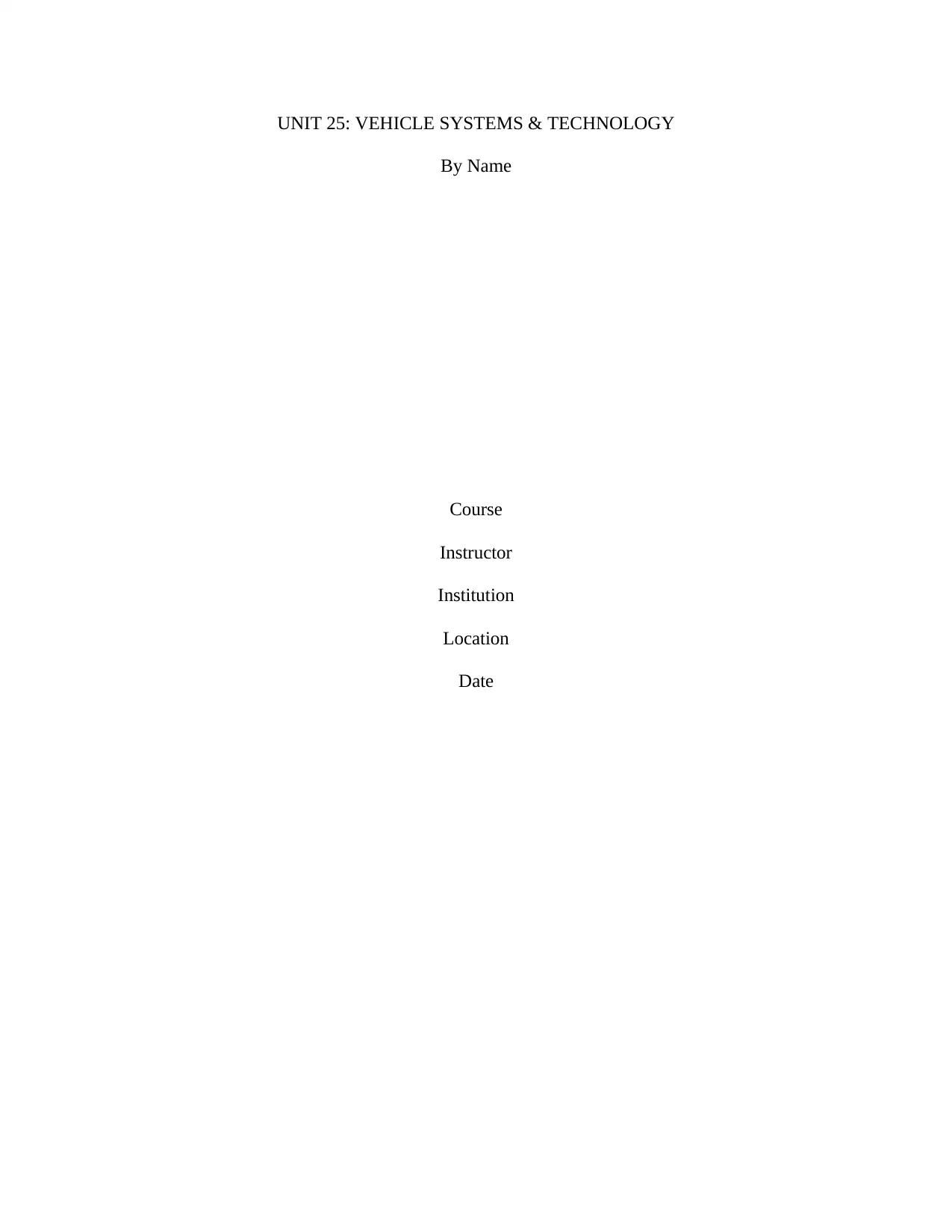
UNIT 25: VEHICLE SYSTEMS & TECHNOLOGY
By Name
Course
Instructor
Institution
Location
Date
By Name
Course
Instructor
Institution
Location
Date
Paraphrase This Document
Need a fresh take? Get an instant paraphrase of this document with our AI Paraphraser
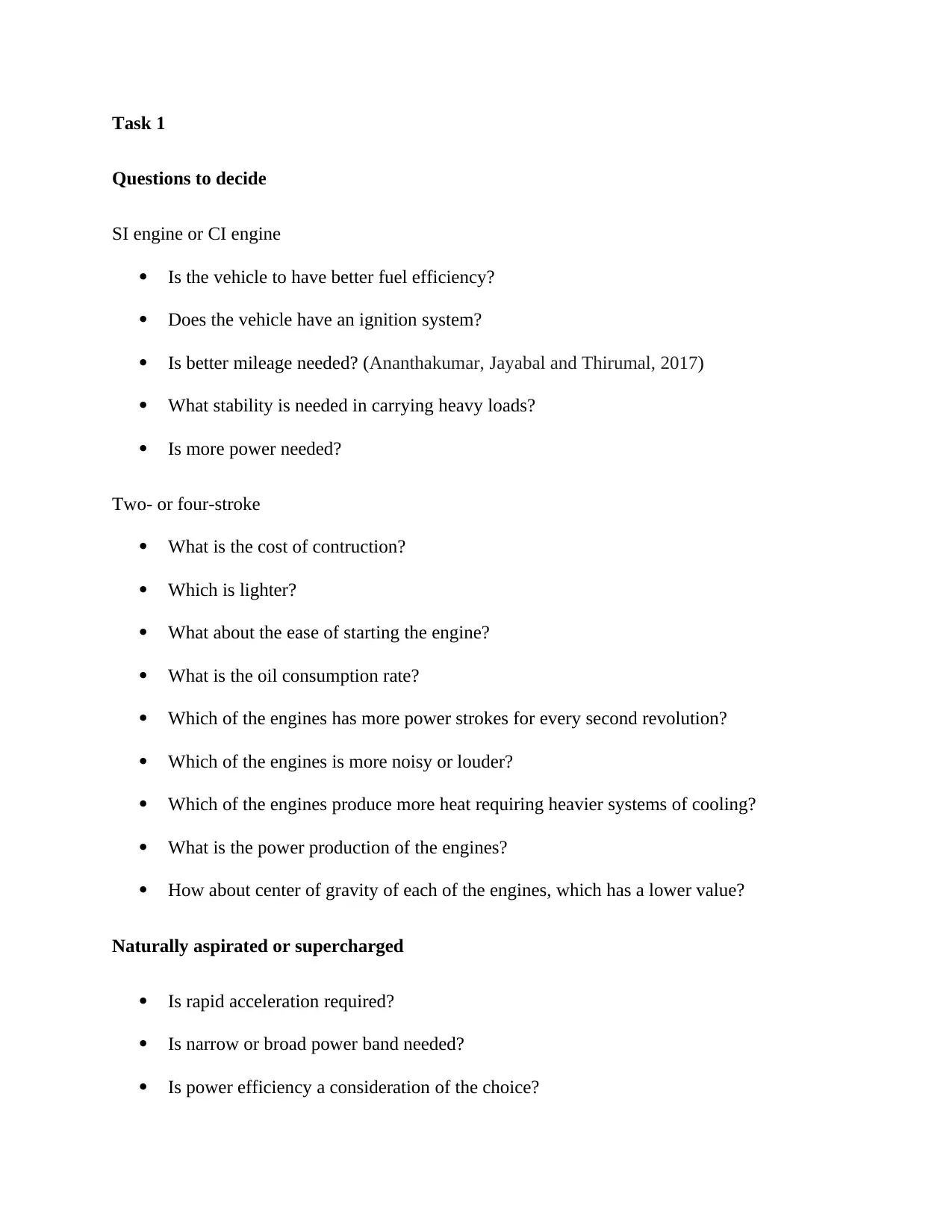
Task 1
Questions to decide
SI engine or CI engine
Is the vehicle to have better fuel efficiency?
Does the vehicle have an ignition system?
Is better mileage needed? (Ananthakumar, Jayabal and Thirumal, 2017)
What stability is needed in carrying heavy loads?
Is more power needed?
Two- or four-stroke
What is the cost of contruction?
Which is lighter?
What about the ease of starting the engine?
What is the oil consumption rate?
Which of the engines has more power strokes for every second revolution?
Which of the engines is more noisy or louder?
Which of the engines produce more heat requiring heavier systems of cooling?
What is the power production of the engines?
How about center of gravity of each of the engines, which has a lower value?
Naturally aspirated or supercharged
Is rapid acceleration required?
Is narrow or broad power band needed?
Is power efficiency a consideration of the choice?
Questions to decide
SI engine or CI engine
Is the vehicle to have better fuel efficiency?
Does the vehicle have an ignition system?
Is better mileage needed? (Ananthakumar, Jayabal and Thirumal, 2017)
What stability is needed in carrying heavy loads?
Is more power needed?
Two- or four-stroke
What is the cost of contruction?
Which is lighter?
What about the ease of starting the engine?
What is the oil consumption rate?
Which of the engines has more power strokes for every second revolution?
Which of the engines is more noisy or louder?
Which of the engines produce more heat requiring heavier systems of cooling?
What is the power production of the engines?
How about center of gravity of each of the engines, which has a lower value?
Naturally aspirated or supercharged
Is rapid acceleration required?
Is narrow or broad power band needed?
Is power efficiency a consideration of the choice?
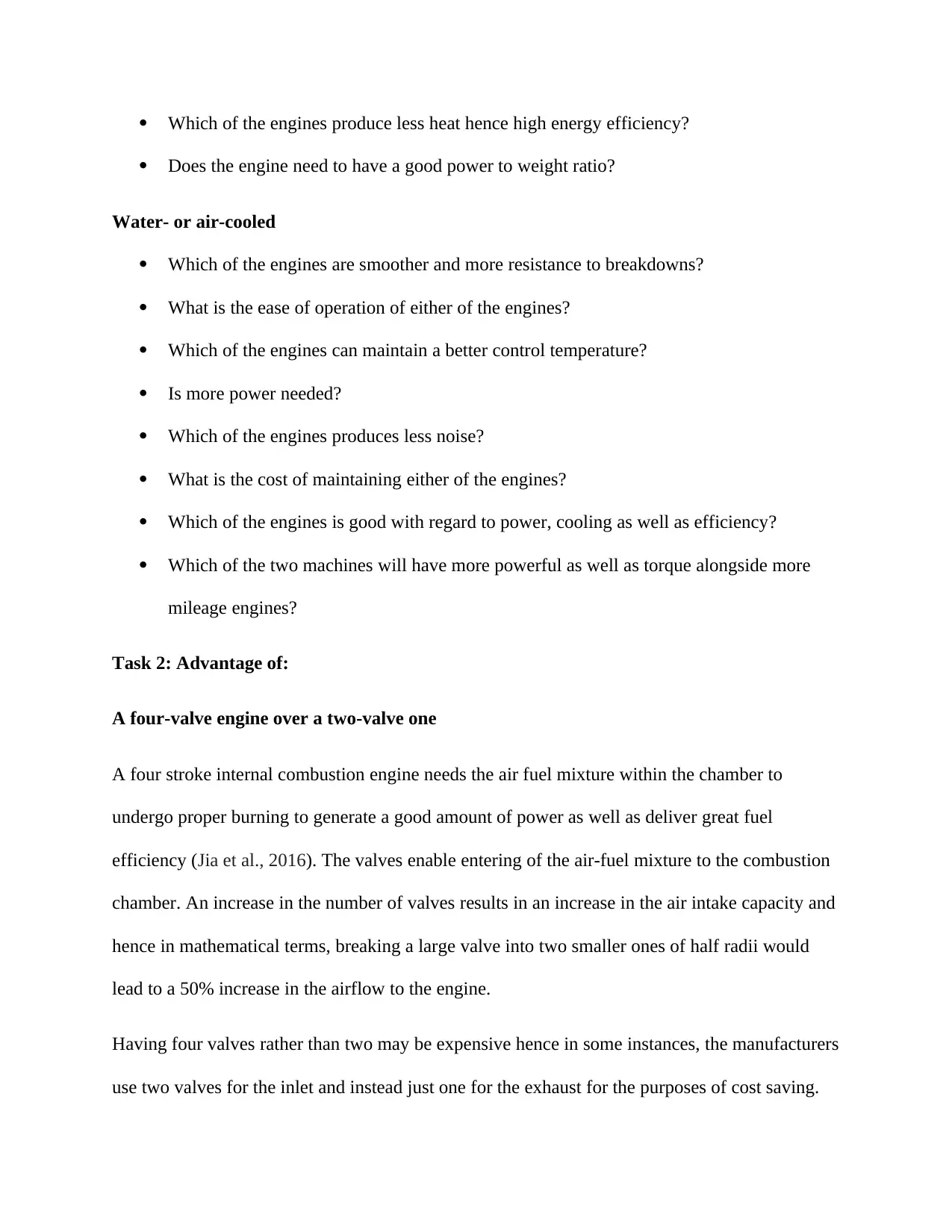
Which of the engines produce less heat hence high energy efficiency?
Does the engine need to have a good power to weight ratio?
Water- or air-cooled
Which of the engines are smoother and more resistance to breakdowns?
What is the ease of operation of either of the engines?
Which of the engines can maintain a better control temperature?
Is more power needed?
Which of the engines produces less noise?
What is the cost of maintaining either of the engines?
Which of the engines is good with regard to power, cooling as well as efficiency?
Which of the two machines will have more powerful as well as torque alongside more
mileage engines?
Task 2: Advantage of:
A four-valve engine over a two-valve one
A four stroke internal combustion engine needs the air fuel mixture within the chamber to
undergo proper burning to generate a good amount of power as well as deliver great fuel
efficiency (Jia et al., 2016). The valves enable entering of the air-fuel mixture to the combustion
chamber. An increase in the number of valves results in an increase in the air intake capacity and
hence in mathematical terms, breaking a large valve into two smaller ones of half radii would
lead to a 50% increase in the airflow to the engine.
Having four valves rather than two may be expensive hence in some instances, the manufacturers
use two valves for the inlet and instead just one for the exhaust for the purposes of cost saving.
Does the engine need to have a good power to weight ratio?
Water- or air-cooled
Which of the engines are smoother and more resistance to breakdowns?
What is the ease of operation of either of the engines?
Which of the engines can maintain a better control temperature?
Is more power needed?
Which of the engines produces less noise?
What is the cost of maintaining either of the engines?
Which of the engines is good with regard to power, cooling as well as efficiency?
Which of the two machines will have more powerful as well as torque alongside more
mileage engines?
Task 2: Advantage of:
A four-valve engine over a two-valve one
A four stroke internal combustion engine needs the air fuel mixture within the chamber to
undergo proper burning to generate a good amount of power as well as deliver great fuel
efficiency (Jia et al., 2016). The valves enable entering of the air-fuel mixture to the combustion
chamber. An increase in the number of valves results in an increase in the air intake capacity and
hence in mathematical terms, breaking a large valve into two smaller ones of half radii would
lead to a 50% increase in the airflow to the engine.
Having four valves rather than two may be expensive hence in some instances, the manufacturers
use two valves for the inlet and instead just one for the exhaust for the purposes of cost saving.
⊘ This is a preview!⊘
Do you want full access?
Subscribe today to unlock all pages.

Trusted by 1+ million students worldwide
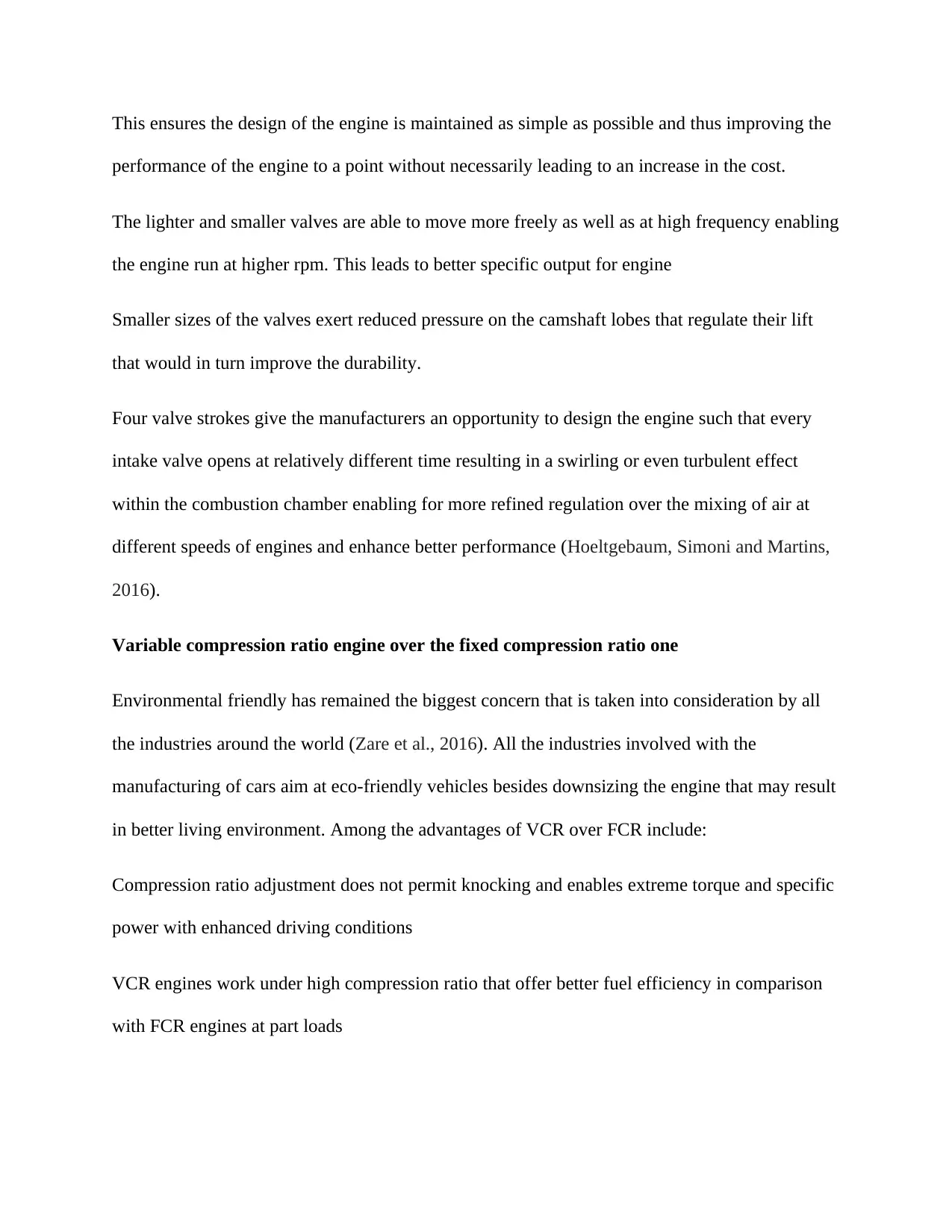
This ensures the design of the engine is maintained as simple as possible and thus improving the
performance of the engine to a point without necessarily leading to an increase in the cost.
The lighter and smaller valves are able to move more freely as well as at high frequency enabling
the engine run at higher rpm. This leads to better specific output for engine
Smaller sizes of the valves exert reduced pressure on the camshaft lobes that regulate their lift
that would in turn improve the durability.
Four valve strokes give the manufacturers an opportunity to design the engine such that every
intake valve opens at relatively different time resulting in a swirling or even turbulent effect
within the combustion chamber enabling for more refined regulation over the mixing of air at
different speeds of engines and enhance better performance (Hoeltgebaum, Simoni and Martins,
2016).
Variable compression ratio engine over the fixed compression ratio one
Environmental friendly has remained the biggest concern that is taken into consideration by all
the industries around the world (Zare et al., 2016). All the industries involved with the
manufacturing of cars aim at eco-friendly vehicles besides downsizing the engine that may result
in better living environment. Among the advantages of VCR over FCR include:
Compression ratio adjustment does not permit knocking and enables extreme torque and specific
power with enhanced driving conditions
VCR engines work under high compression ratio that offer better fuel efficiency in comparison
with FCR engines at part loads
performance of the engine to a point without necessarily leading to an increase in the cost.
The lighter and smaller valves are able to move more freely as well as at high frequency enabling
the engine run at higher rpm. This leads to better specific output for engine
Smaller sizes of the valves exert reduced pressure on the camshaft lobes that regulate their lift
that would in turn improve the durability.
Four valve strokes give the manufacturers an opportunity to design the engine such that every
intake valve opens at relatively different time resulting in a swirling or even turbulent effect
within the combustion chamber enabling for more refined regulation over the mixing of air at
different speeds of engines and enhance better performance (Hoeltgebaum, Simoni and Martins,
2016).
Variable compression ratio engine over the fixed compression ratio one
Environmental friendly has remained the biggest concern that is taken into consideration by all
the industries around the world (Zare et al., 2016). All the industries involved with the
manufacturing of cars aim at eco-friendly vehicles besides downsizing the engine that may result
in better living environment. Among the advantages of VCR over FCR include:
Compression ratio adjustment does not permit knocking and enables extreme torque and specific
power with enhanced driving conditions
VCR engines work under high compression ratio that offer better fuel efficiency in comparison
with FCR engines at part loads
Paraphrase This Document
Need a fresh take? Get an instant paraphrase of this document with our AI Paraphraser

VCR engines lower emission pollutant through retaining in best combination between
compression ratio and ignition advance.
VCR to a great extent maintains the thermodynamic temperature of engine low in comparison
with FCR through working under desirable compression ratio range as well as avoiding heating
of engine
It allows increasing the load speed range that may lead to effectiveness in lean-mixtures. The
temperature as well as pressure controls that allow combustion under ultra-lean mixtures besides
setting the auto-ignition timing accurately
Common rail technology over the conventional diesel injection technology
The general vehicle efficiency enhance with pleasant conditions for driving
Lower emissions: There is hardly any more release of large masses of smoke into the air by
trucks due to common rail diesel engine that have been designed in such a way that they lower
the emissions hence making the environment better as a step in the direction of fighting global
warming (Heywood, 2017).
Less noise: Direct fuel injection systems were associated with a lot noise when driving, a
situation that has been changed by common rail diesel engine making driving a more pleasant
experience for the road users
More power: Vehicles having common rail diesel engines have been demonstrated through
studies to be producing 25% more power in comparison with the conventional diesel engines.
This translates to an increase in the overall performance of the diesel engine (Heywood, 2017)
compression ratio and ignition advance.
VCR to a great extent maintains the thermodynamic temperature of engine low in comparison
with FCR through working under desirable compression ratio range as well as avoiding heating
of engine
It allows increasing the load speed range that may lead to effectiveness in lean-mixtures. The
temperature as well as pressure controls that allow combustion under ultra-lean mixtures besides
setting the auto-ignition timing accurately
Common rail technology over the conventional diesel injection technology
The general vehicle efficiency enhance with pleasant conditions for driving
Lower emissions: There is hardly any more release of large masses of smoke into the air by
trucks due to common rail diesel engine that have been designed in such a way that they lower
the emissions hence making the environment better as a step in the direction of fighting global
warming (Heywood, 2017).
Less noise: Direct fuel injection systems were associated with a lot noise when driving, a
situation that has been changed by common rail diesel engine making driving a more pleasant
experience for the road users
More power: Vehicles having common rail diesel engines have been demonstrated through
studies to be producing 25% more power in comparison with the conventional diesel engines.
This translates to an increase in the overall performance of the diesel engine (Heywood, 2017)
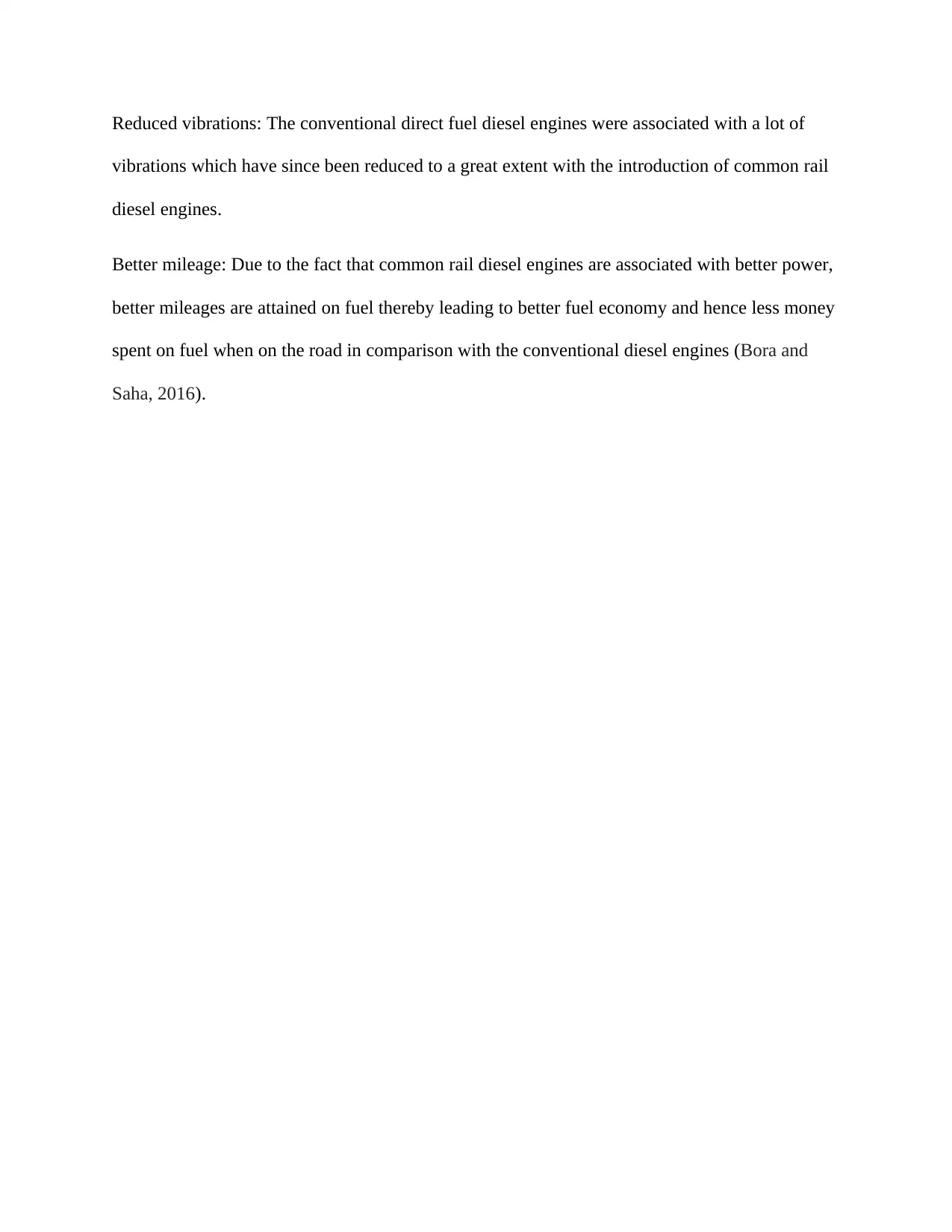
Reduced vibrations: The conventional direct fuel diesel engines were associated with a lot of
vibrations which have since been reduced to a great extent with the introduction of common rail
diesel engines.
Better mileage: Due to the fact that common rail diesel engines are associated with better power,
better mileages are attained on fuel thereby leading to better fuel economy and hence less money
spent on fuel when on the road in comparison with the conventional diesel engines (Bora and
Saha, 2016).
vibrations which have since been reduced to a great extent with the introduction of common rail
diesel engines.
Better mileage: Due to the fact that common rail diesel engines are associated with better power,
better mileages are attained on fuel thereby leading to better fuel economy and hence less money
spent on fuel when on the road in comparison with the conventional diesel engines (Bora and
Saha, 2016).
⊘ This is a preview!⊘
Do you want full access?
Subscribe today to unlock all pages.

Trusted by 1+ million students worldwide
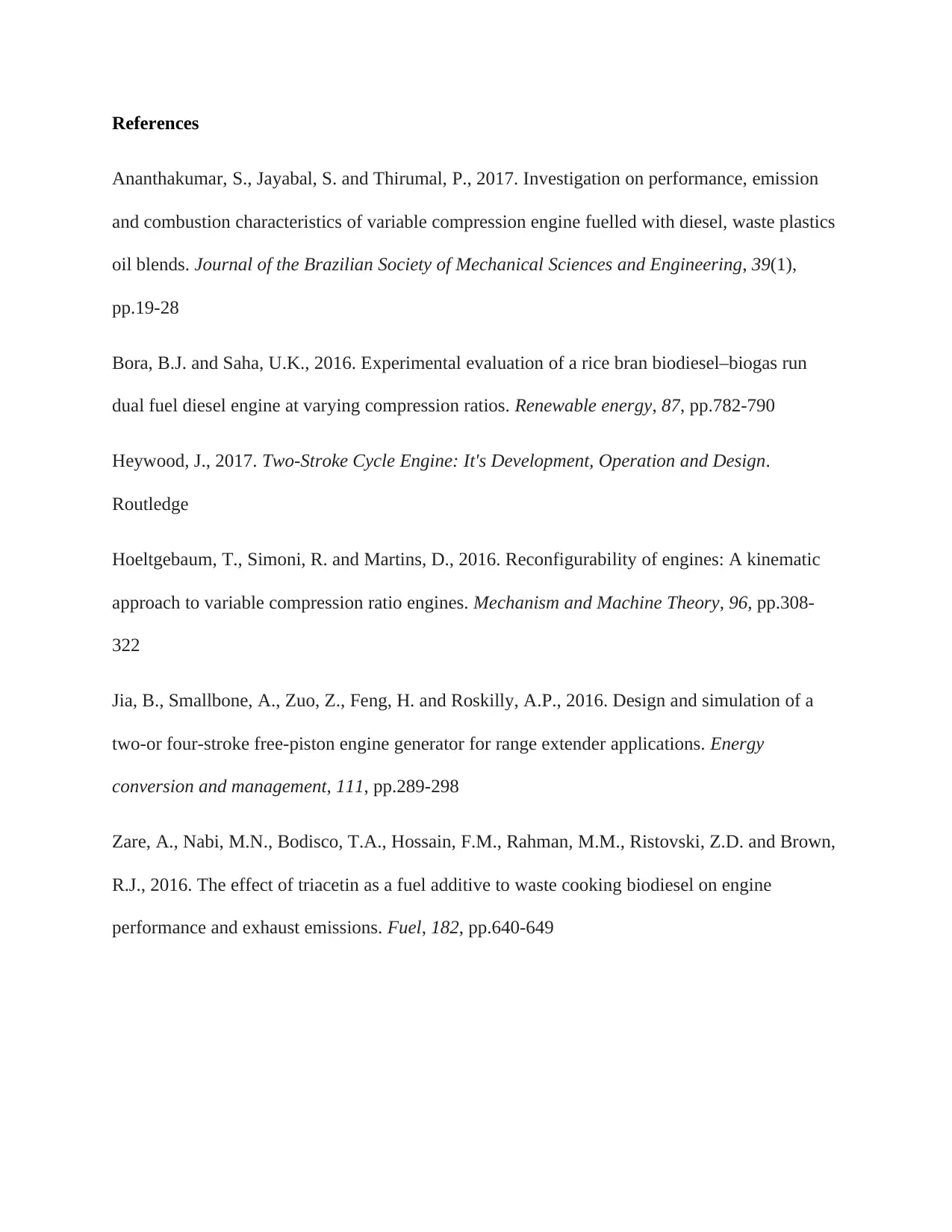
References
Ananthakumar, S., Jayabal, S. and Thirumal, P., 2017. Investigation on performance, emission
and combustion characteristics of variable compression engine fuelled with diesel, waste plastics
oil blends. Journal of the Brazilian Society of Mechanical Sciences and Engineering, 39(1),
pp.19-28
Bora, B.J. and Saha, U.K., 2016. Experimental evaluation of a rice bran biodiesel–biogas run
dual fuel diesel engine at varying compression ratios. Renewable energy, 87, pp.782-790
Heywood, J., 2017. Two-Stroke Cycle Engine: It's Development, Operation and Design.
Routledge
Hoeltgebaum, T., Simoni, R. and Martins, D., 2016. Reconfigurability of engines: A kinematic
approach to variable compression ratio engines. Mechanism and Machine Theory, 96, pp.308-
322
Jia, B., Smallbone, A., Zuo, Z., Feng, H. and Roskilly, A.P., 2016. Design and simulation of a
two-or four-stroke free-piston engine generator for range extender applications. Energy
conversion and management, 111, pp.289-298
Zare, A., Nabi, M.N., Bodisco, T.A., Hossain, F.M., Rahman, M.M., Ristovski, Z.D. and Brown,
R.J., 2016. The effect of triacetin as a fuel additive to waste cooking biodiesel on engine
performance and exhaust emissions. Fuel, 182, pp.640-649
Ananthakumar, S., Jayabal, S. and Thirumal, P., 2017. Investigation on performance, emission
and combustion characteristics of variable compression engine fuelled with diesel, waste plastics
oil blends. Journal of the Brazilian Society of Mechanical Sciences and Engineering, 39(1),
pp.19-28
Bora, B.J. and Saha, U.K., 2016. Experimental evaluation of a rice bran biodiesel–biogas run
dual fuel diesel engine at varying compression ratios. Renewable energy, 87, pp.782-790
Heywood, J., 2017. Two-Stroke Cycle Engine: It's Development, Operation and Design.
Routledge
Hoeltgebaum, T., Simoni, R. and Martins, D., 2016. Reconfigurability of engines: A kinematic
approach to variable compression ratio engines. Mechanism and Machine Theory, 96, pp.308-
322
Jia, B., Smallbone, A., Zuo, Z., Feng, H. and Roskilly, A.P., 2016. Design and simulation of a
two-or four-stroke free-piston engine generator for range extender applications. Energy
conversion and management, 111, pp.289-298
Zare, A., Nabi, M.N., Bodisco, T.A., Hossain, F.M., Rahman, M.M., Ristovski, Z.D. and Brown,
R.J., 2016. The effect of triacetin as a fuel additive to waste cooking biodiesel on engine
performance and exhaust emissions. Fuel, 182, pp.640-649
1 out of 7
Related Documents
Your All-in-One AI-Powered Toolkit for Academic Success.
+13062052269
info@desklib.com
Available 24*7 on WhatsApp / Email
![[object Object]](/_next/static/media/star-bottom.7253800d.svg)
Unlock your academic potential
Copyright © 2020–2025 A2Z Services. All Rights Reserved. Developed and managed by ZUCOL.



